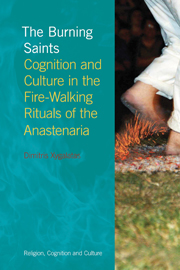Book contents
- Frontmatter
- Dedication
- Contents
- List of illustrations
- Acknowledgements
- 1 Introduction
- 2 Tradition in the making
- 3 The ethnographic setting
- 4 Fire-walking in Agia Eleni
- 5 Knowledge and revelation among the Anastenaria
- 6 Ritual and mind
- 7 Costly rituals
- 8 Arousal, emotion and motivation
- 9 The physiology of high-arousal rituals
- 10 Putting it all together
- Notes
- Bibliography
- Index
10 - Putting it all together
- Frontmatter
- Dedication
- Contents
- List of illustrations
- Acknowledgements
- 1 Introduction
- 2 Tradition in the making
- 3 The ethnographic setting
- 4 Fire-walking in Agia Eleni
- 5 Knowledge and revelation among the Anastenaria
- 6 Ritual and mind
- 7 Costly rituals
- 8 Arousal, emotion and motivation
- 9 The physiology of high-arousal rituals
- 10 Putting it all together
- Notes
- Bibliography
- Index
Summary
In this volume I have treated the rituals of the Anastenaria from a variety of perspectives: historical, social, cultural, evolutionary, psychological and biological. This multiplicity of analytical levels stems from the realization that humans are at the same time biologically based, historically situated, culturally embedded and psychologically driven social beings. This basic assumption may seem intuitive to many, and has indeed long been acknowledged by social scientists who called for a “socio-psycho-biological” study of culture (Mauss 1935: 122; Ignatow 2012). However, there are stark debates on the relationship between the various levels of explanation applied to human behaviour, leading to radically different approaches and often resulting in fragmented and conflicting views of human nature. This book has followed an integrationist rather than an isolationist path, based on a multilevel view of cultural phenomena.
Explanatory pluralism and multilevel analysis of culture
Most accounts of the relation between the biological, psychological and socio-cultural levels of analysis tend to subscribe to either one of two antithetical epistemological stances: a reductionist methodological individualism (the view that cultural phenomena can be adequately explained by the drives and actions of individuals) and a social constructivist position that culture is the sole determinant of human thought and behaviour (Thagard 2010, forthcoming).
- Type
- Chapter
- Information
- The Burning SaintsCognition and Culture in the Fire-Walking Rituals of the Anastenaria, pp. 185 - 196Publisher: Acumen PublishingPrint publication year: 2012



